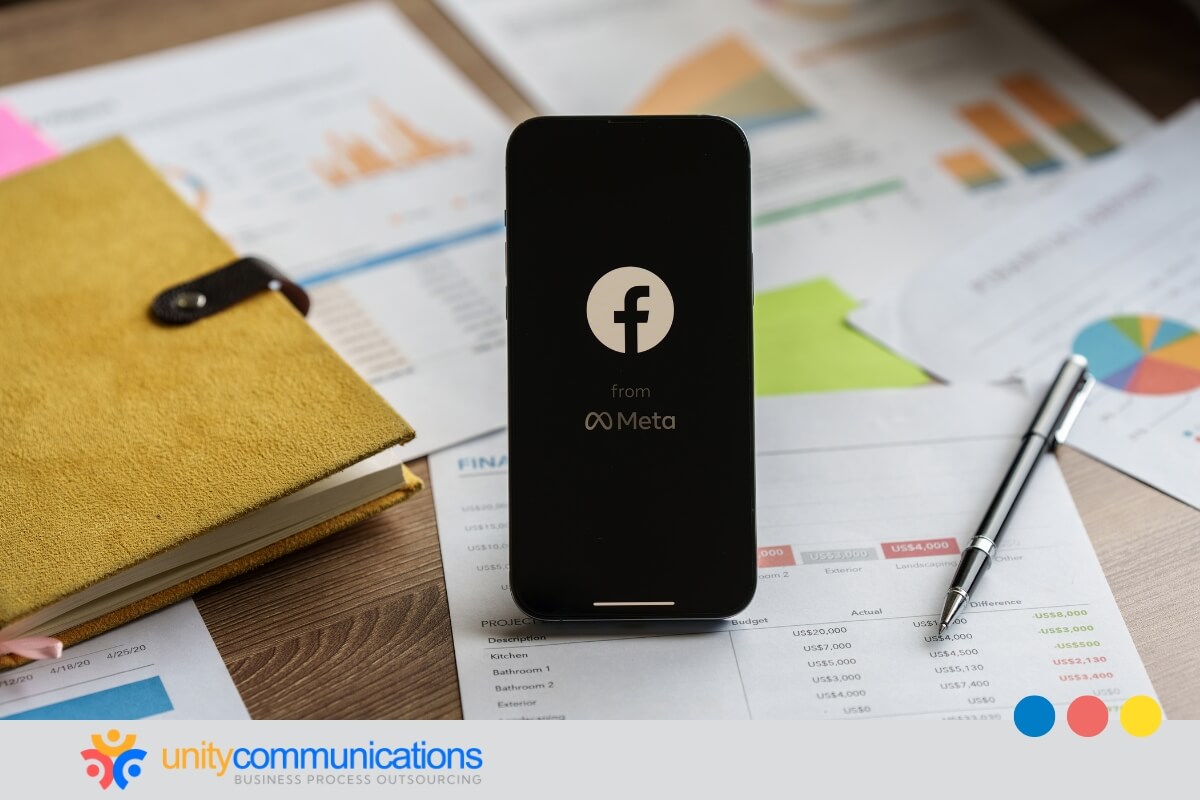Table of Contents
With billions of users on platforms like Facebook, Instagram, LinkedIn, and TikTok, small businesses have an unprecedented opportunity to connect with their target audience, build brand awareness, and drive sales.
However, managing these sites requires resources and expertise. This is where social media marketing services through business process outsourcing (BPO) become game-changers.
This guide examines the most effective social media marketing strategies for small businesses and how leveraging BPO services can enhance efficiency and deliver better results.
Best practices in social media marketing for small businesses

Small-sized enterprises require a well-defined strategy to engage the audience, optimize messaging, and track performance to maximize social marketing benefits.
Choosing the right platforms, maintaining consistency, and using data-driven insights are key to effective social media marketing. This section explores strategies that can boost your efforts and support meaningful growth for your small business.
1. Set clear goals and define your target audience
A well-planned social media strategy yields measurable results by aligning your brand identity, target audience, and overall business objectives. It also maintains consistency, improves engagement, and maximizes return on investment.
Before launching a social media campaign, clearly define your goals to accurately track progress and adjust strategies based on performance metrics. Some common social media marketing objectives for small businesses include:
- Increasing brand awareness by growing followers and engagement
- Generating leads and sales through social ad campaigns
- Improving customer engagement by promptly responding to inquiries and comments
- Driving website traffic through strategic content sharing and linking
- Building a community by fostering discussions and user-generated content (UGC)
Understanding the target audience is crucial for creating content that resonates with potential customers. Analyze customer demographics, interests, and behaviors to identify which platforms they frequently use and what types of content they prefer. Conducting surveys, reviewing customer feedback, and using analytics tools can provide valuable insights to refine the social media approach.
2. Select the right social media platforms for your business
When engaging in social media marketing for small businesses, selecting the right platforms is crucial to reaching the right audience and maximizing impact. Each serves a purpose and attracts a distinct demographic.
Instead of being active on every platform, focus on those that align best with your target market, industry, and content style. Analyze your target audience’s demographics, interests, and online behavior. Consider the audience’s age, location, preferences, and content engagement.
For example:
- Younger audiences (18–24 years old) are more active on TikTok and Instagram.
- Professionals and B2B audiences engage more on LinkedIn.
- Local communities and older people frequently use Facebook.
Different businesses thrive on various sites, depending on their industry and objectives:
- Facebook is ideal for businesses seeking to establish a community, engage with customers, and run targeted ads. Examples include retail, service-based companies, and local shops.
- Instagram is particularly well-suited for brands with strong visual content, such as those in the fashion, beauty, food, and lifestyle industries. It can tell stories through images, reels, and influencer marketing.
- LinkedIn is the go-to platform for B2B companies, professional services, and personal branding. It is helpful for networking, gaining industry insights, and generating leads.
- TikTok is best for small businesses targeting younger audiences with engaging, short-form video content. It works well for creative industries, entertainment, and viral marketing.
- X (formerly Twitter) is suitable for real-time updates, customer service, and thought leadership. The channel is ideal for tech, news, and service-based businesses.
- YouTube is best for long-form educational content, tutorials, and brand storytelling. Businesses can create videos to engage audiences.
Each platform also supports various content formats, including images, videos, stories, and live streams. If your business thrives on visuals, Instagram, Pinterest, and TikTok are great choices.
If you share industry insights and B2B content, LinkedIn and X (Twitter) are better options. If customer interaction and community engagement are priorities, Facebook and Instagram offer robust engagement tools, such as groups and messaging.
3. Develop a comprehensive content plan
A strong content plan is crucial in social media marketing for small businesses to maintain consistency, engage their audience, and achieve marketing objectives. Without a structured approach, social media efforts become inconsistent and ineffective.
A well-thought-out plan produces high-quality content that aligns with your brand and core audience. To achieve this, you must choose the right content types. A diverse mix keeps the audience engaged and prevents social media pages from feeling repetitive.
You can appeal to or engage various audience segments by balancing different content types. Examples include:
- Educational content: how-to guides, industry insights, and tips to provide value to followers
- Engaging content: polls, quizzes, and UGC that encourage interaction
- Promotional content: product highlights, special offers, and discounts to drive sales
- Behind-the-scenes content: company culture, employee stories, and business operations to humanize your brand
- Testimonials and case studies: customer reviews and success stories to build credibility
- Trending content: trending topics, challenges, and hashtags to boost visibility
Experienced BPO teams also create a content calendar to enhance social media management. Platforms can schedule posts in advance and streamline content planning, allowing for more efficient content creation.
A typical content calendar includes the following:
- Content type (e.g., video, infographic, blog post)
- Platform (Facebook, Instagram, LinkedIn, etc.)
- Captions and hashtags for each post
- Posting schedule (daily, weekly, or bi-weekly)
With a solid content plan and calendar in place, your business is ready to focus on crafting engaging content that captivates your audience and builds lasting connections.
4. Create high-quality and engaging content
Engaging content captures audience attention, builds relationships, and converts followers into customers. To ease the competition, you need compelling, value-driven content that resonates with your audience and encourages interaction.
One effective strategy is storytelling. Many prefer stories over promotional messages because they add authenticity and help the audience feel emotionally connected to the brand.
Instead of merely showcasing products, create narratives about your brand, customers, or industry. Examples include:
- Sharing a personal journey about how the business started
- Highlighting customer success stories and testimonials
- Showing behind-the-scenes moments to humanize the brand
Visual content also engages the audience more than text-only posts. Eye-catching visuals are crucial in stopping users from scrolling past a copy. You can use:
- High-quality images to showcase products
- Short-form vertical videos to engage the audience quickly
- Infographics to present helpful information in a digestible format
- Live videos for Q&A sessions, product demos, or behind-the-scenes content to demonstrate the product or service
Another excellent strategy in social media marketing for small businesses is producing user-generated content (UGC), as it fosters trust and authenticity. You can encourage customers to share their experiences with the brand through:
- Creating a branded hashtag and featuring customer posts
- Running contests or giveaways that require user participation
- Asking for customer reviews and sharing them as posts
When potential customers see real people using and enjoying your product or service, they are more likely to trust you and make a purchase.
Social media is also about interacting, especially since 64% of customers want brands to connect with them. You can strengthen relationships and increase customer loyalty by actively engaging with followers by:
- Responding to comments and messages quickly
- Asking engaging questions in captions to encourage discussions
- Using polls, quizzes, and interactive stickers (on Instagram Stories, for example)
- Creating relatable memes and fun challenges to spark conversations
Finally, you can leverage business process outsourcing for content creation. Creating high-quality content consistently can be time-consuming for small businesses. External providers can handle content writing, graphic design, video editing, and post scheduling. This way, you can focus on core operations while amplifying your social media presence.
5. Measure and analyze social media performance
Tracking and analyzing social media performance lets you understand what’s working and needs improvement. Otherwise, you might waste time and resources on ineffective strategies.
Some relevant key performance indicators (KPIs) to track to measure social media success are:
- Engagement rate. Likes, comments, shares, and saves indicate audience interaction.
- Reach and impressions. The number of people who see your content helps determine brand visibility.
- Follower growth. Tracking new followers helps determine your brand’s reach and potential engagement rate.
- Click-through rate (CTR). It measures the number of users who click on links in your posts, resulting in website traffic.
- Conversion rate. This metric tracks the number of social media interactions, resulting in sales, sign-ups, or other business objectives.
Many social media platforms already feature analytics tools to track real-time performance. For example, Facebook Insights and Instagram Analytics can measure engagement, reach, and audience demographics.
LinkedIn Analytics can monitor content engagement and follower growth for B2B organizations, while Google Analytics examines website traffic from social media platforms. Third-party tools, such as Hootsuite, Buffer, and Sprout Social, provide in-depth analysis across multiple platforms.
These applications can also analyze your competitors’ performance to gain valuable insights on their strengths and weaknesses. By identifying which posts perform well for them, you can refine your social media strategy and exceed their results.
Despite the benefits of social media analytics, you might lack the time or expertise to track and analyze data. Consider partnering with a BPO company to simplify the process. How outsourcing works in this case is that specialized digital marketing agencies or social media management firms handle tasks such as:
- Monitoring analytics and generating performance reports
- Providing data-driven insights to improve social media strategies
- Managing paid advertising campaigns for better returns
- Engaging with customers and responding to inquiries in real time
With data-driven insights, you can optimize your social media marketing efforts and achieve better results.
Importance of social media marketing for small businesses
Social media marketing is crucial for small businesses for many reasons. It provides a cost-effective way to reach and engage with potential customers. With about 5.24 billion users worldwide as of 2025, social media platforms can drive brand awareness, generate leads, and boost sales.
Social media strengthens two-way communication between your business and the audience. Unlike traditional ads that push messages to consumers, social media enables real-time conversations. You can respond to customer questions, address concerns, and receive instant feedback, which helps build customer loyalty and brand trust.
Engaging videos, live streams, and UGCs also enhance brand authenticity and encourage word-of-mouth marketing, one of the most potent forms of promotion. They also level the playing field by letting you compete with established brands, even with limited marketing budgets.
Studies show that 78% of consumers are more likely to buy from a brand after having a positive experience with it on social media. This marketing approach can establish your brand, attract new customers, and maintain long-term relationships. With a well-thought-out strategy, you can create a loyal customer base that drives growth and success.
How outsourcing social media marketing can be beneficial

Due to limited time, resources, and skills, small businesses often struggle to maintain an active and effective social media presence. Outsourcing social media marketing allows you to leverage professional expertise while saving time and reducing costs.
Here’s how outsourcing social media marketing can help your small business:
- Cost savings. Hiring an in-house social media team can be expensive, considering salaries, benefits, training, and software costs. Conversely, outsourcing can reduce operating costs by as much as 70%. It eliminates the need for full-time staffing, software subscriptions, and training expenses.
- Access to experts and advanced tools. Social media marketing requires expertise in content creation, advertising, analytics, and audience engagement. BPO companies can provide experienced marketers, graphic designers, and video editors to produce high-quality content and paid ads specialists to maximize ROI.
- Time efficiency. Running a small business requires juggling multiple responsibilities. Handling social media marketing in-house can take time away from product development, customer service, and sales. Outsourcing ensures consistent posting and engagement without delays and frees internal resources for strategic growth initiatives.
- Scalable marketing solutions. Outsourcing enables you to scale your social media efforts according to your needs. Whether launching a new campaign, increasing seasonal promotions, or expanding to new platforms, you can adjust your outsourcing solutions without the hassle of hiring and training new employees.
- Data-driven strategies. BPO providers and marketing agencies use analytics to track engagement, conversions, and audience behavior. When you outsource, you get data-driven insights that optimize marketing strategies. Experts continually test and refine content, ad campaigns, and posting schedules for optimal performance.
Outsourcing social media marketing gives small businesses the expertise, flexibility, and efficiency they need to stay competitive. It’s a powerful strategy for driving sustainable growth and boosting brand visibility.
The bottom line
Social media is a direct line to customers, a brand storytelling platform, and a business growth driver. However, navigating its complexities requires a well-planned strategy and consistent effort.
Whether outsourcing social media marketing for small businesses or managing it in-house, success comes from staying adaptable, data-driven, and customer-focused. By staying informed about platforms, content, and performance tracking, you can harness social media to build lasting relationships and your brand.
Want to learn how you can leverage outsourcing for social media marketing? Let’s connect today to discover how our BPO solutions can elevate your social media presence and accelerate your business growth.




